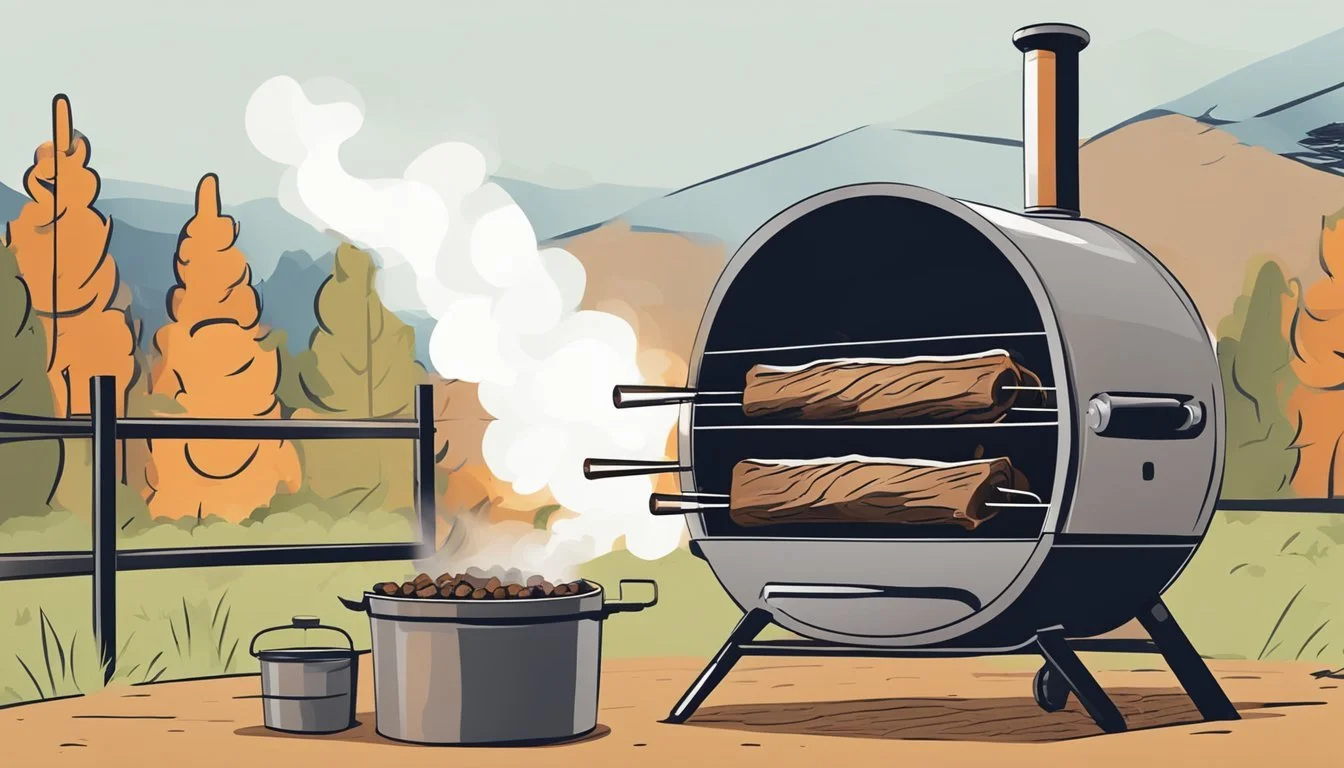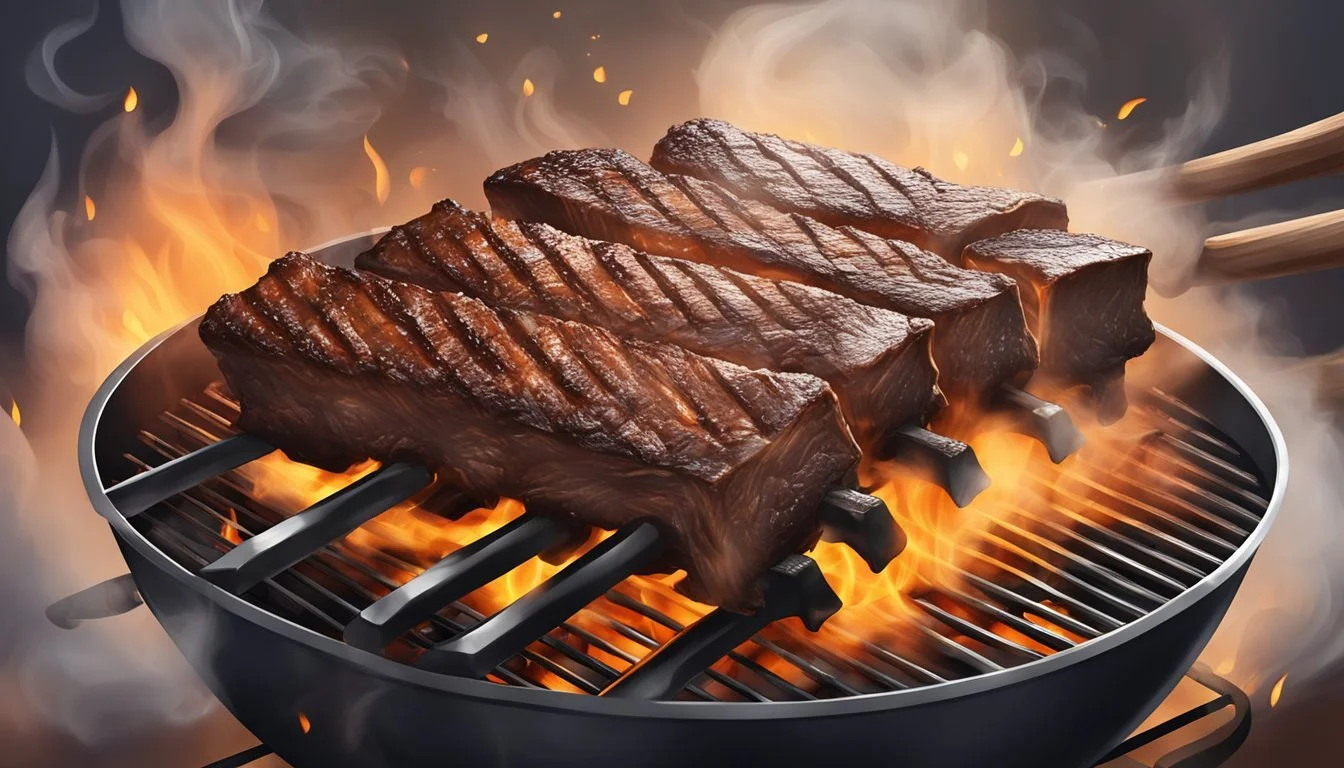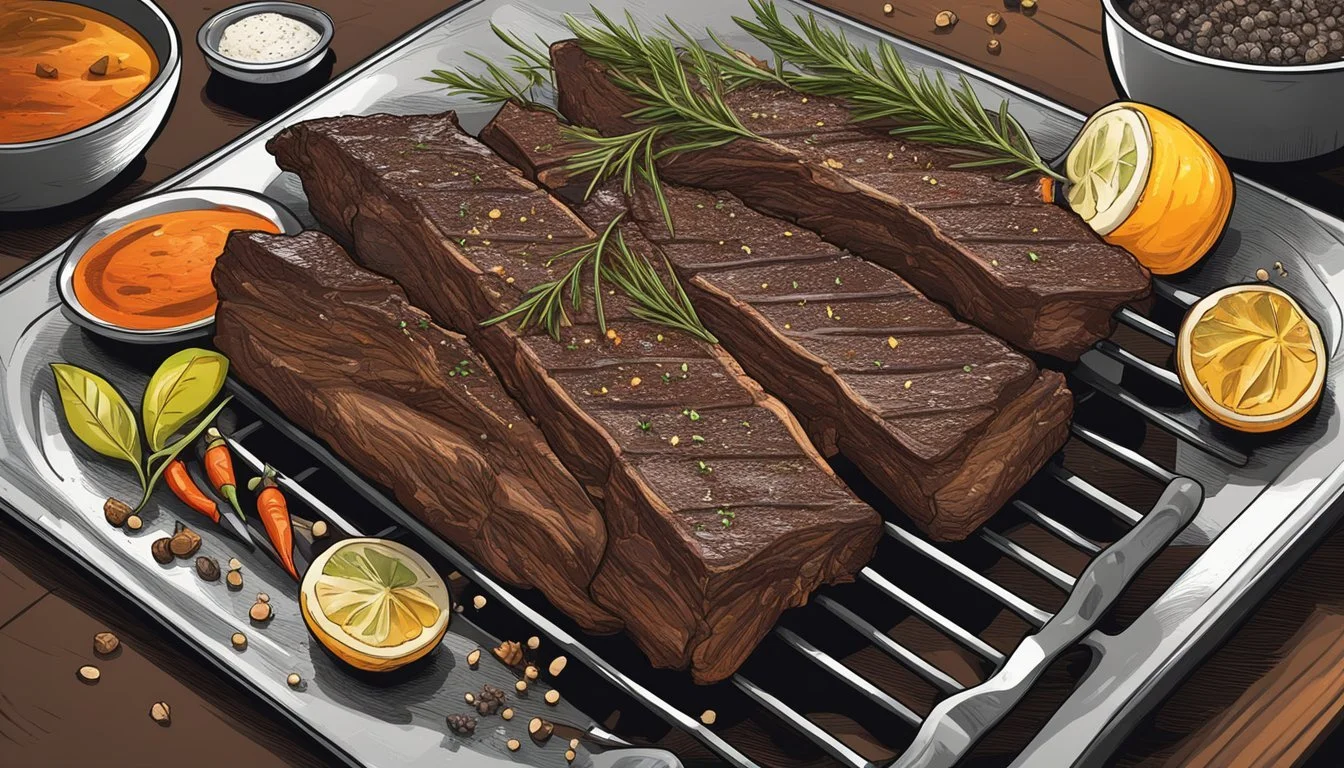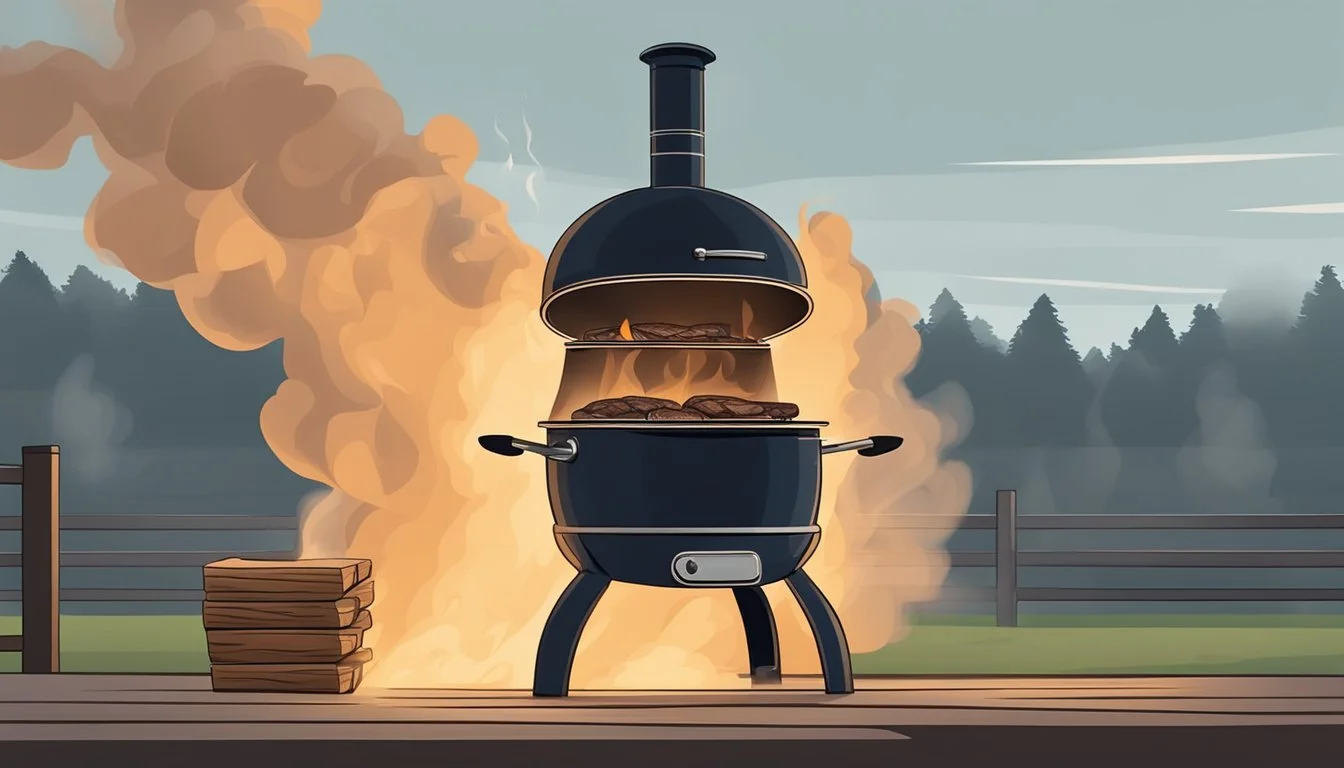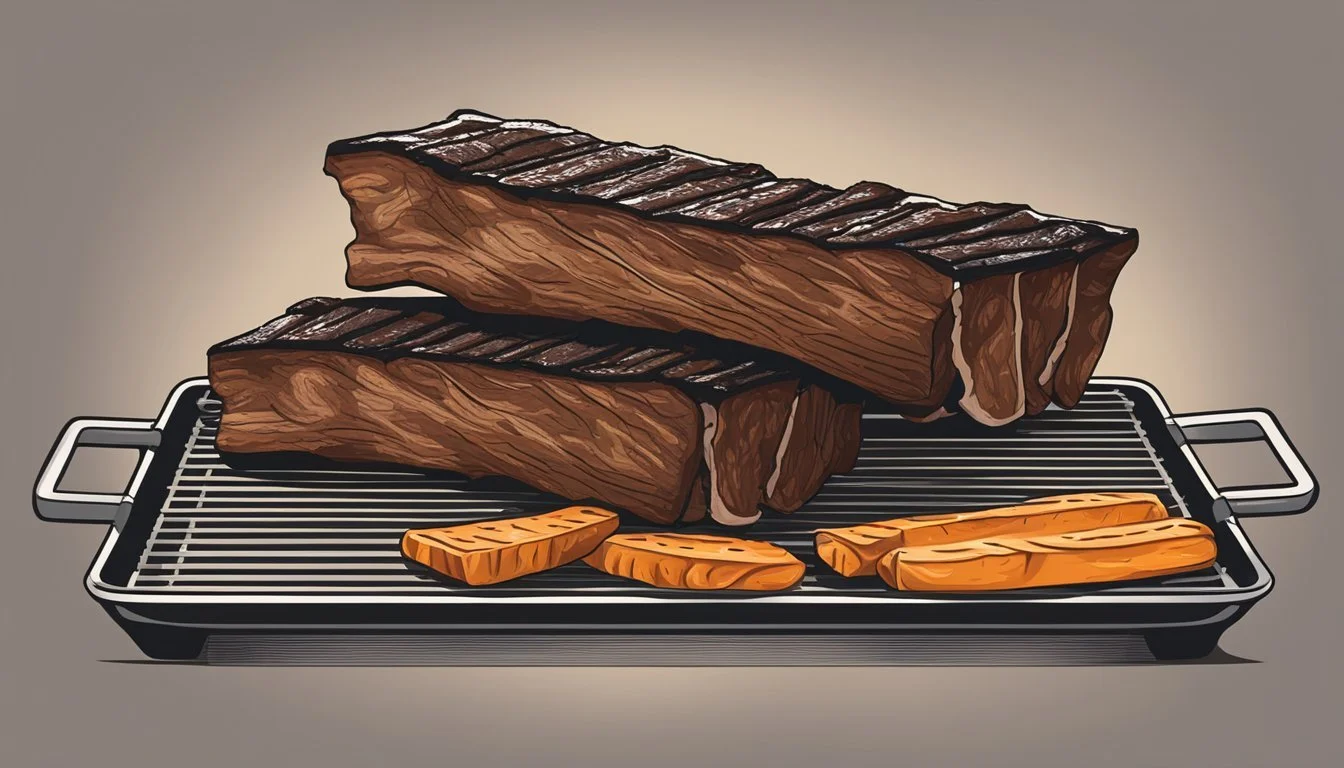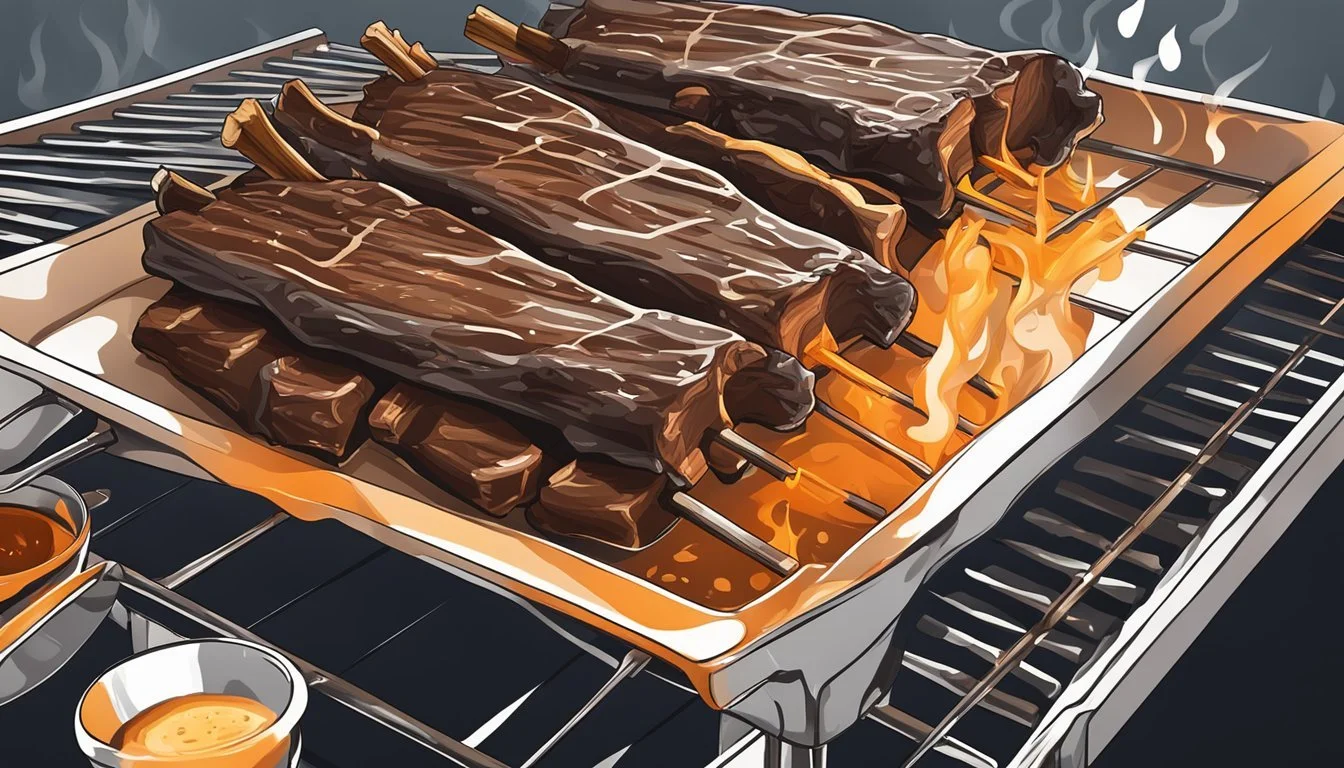Smoking Beef Ribs
Smoking beef (What wine goes well with beef?) ribs is a culinary art that demands patience, skill, and a grasp of the subtleties of this delicious cut of meat. Beef ribs, known for their rich, juicy texture and tantalizing flavor, are a go-to for meat lovers and barbecue enthusiasts. The smoking method, involving low and slow cooking, enhances tenderness and infuses a distinctive smoky flavor. Imagine the succulent ribs on the smoker, the rib method ensuring a perfect outcome. Finish by drizzling a delectable sauce over the ribs for a touch of restaurant-quality deliciousness that elevates this dish to a whole new level.
Exploring a well-crafted beef ribs recipe can elevate your culinary experience, offering a blend of techniques and flavors that result in tender, delicious ribs. The process of smoking ribs involves selecting the perfect cut of beef, preparing and seasoning it to achieve maximum flavor, and utilizing the right equipment and techniques to ensure proper cooking. The key to mastering the smoking technique lies in maintaining a consistent temperature, regulating the smoke, and ensuring enough moisture is present throughout the cooking process.
Smoking ribs is a tasty journey, especially with beef ribs. Whether using a smoker or experimenting with wood types, the key is finding your perfect balance. Start with Sweet Rub or Beef Rub, and add a pinch of salt for that savory touch. Picture a rack of baby back ribs on the smoker, coated in a tantalizing mix of rubs, transforming into a restaurant-quality dish. The method of smoking, paired with a flavorful sauce over the ribs, creates delicious, mouthwatering meat. Elevate the experience by using beef stock for depth of flavor. With attention to detail, you'll savor top-notch ribs at home.
Understanding Beef Ribs
Understanding beef ribs is key to mastering a delicious rack of ribs. Beef Chuck Ribs, known for their bone-tender goodness, are a popular choice. Before cooking, let them marinate for a couple of hours with your favorite rub for optimal flavor absorption.
When it's time to cook, a charcoal grill is your best friend. Achieve the perfect grill temperature and wrap the seasoned beef ribs in heavy-duty aluminum foil or use a Dutch oven for added tenderness. The goal is to create a nice bark on the ribs while they cook.
As you're grilling, baste the ribs with a mouthwatering mix of Sweet Baby Ray's and your favorite sauce. This adds layers of flavor and ensures a delectable outcome. For the finishing touch, consider using pink butcher paper during the cooking process to keep the ribs moist and flavorful.
Whether you enjoy your ribs with or without extra sauce, this is sure to impress. It's all about the method of smoking – from the charcoal grill to the smoker, savor the rich, smoky taste of perfectly prepared beef ribs.
Beef ribs are a popular main course for many meat lovers, known for their rich, smoky flavor. There are different types of beef ribs available in the grocery store, each cut from a specific area of the cow. In this section, we will look at four cuts of beef ribs: Beef Back Ribs, Beef Short Ribs, (What wine goes well with beef short ribs?) Plate Ribs, and Chuck Ribs.
Beef Back Ribs
Beef Back Ribs come from the rib area of the cow, specifically the area close to the spine. They are usually sliced from the prime rib and are individual, narrow, long bones with some meat attached. The standard cut of beef back ribs has 7 to 8 ribs, with meat mostly between the bones. These ribs are relatively lean and tender, suitable for grilling, roasting, and smoking.
Beef Short Ribs
Beef Short Ribs are cut from the lower portion of the rib cage, closer to the chest. They are a very popular cut due to their rich marbling of fat, which adds tenderness and flavor. There are two main cuts of short ribs:
English Cut: Each rib is cut separately with a thick layer of meat on top of the bone.
Flanken Cut: Ribs are cut across the bones, resulting in multiple bones in a single piece with a thinner layer of meat.
Both English and Flanken cuts are perfect for braising, as the slow, moist heat helps break down the connective tissues, resulting in tender and flavorful dishes.
Plate Ribs
Plate Ribs are cut from the lower rib section, directly below the short ribs. They consist of a three-bone set, each bone being larger than the back ribs, making them the largest cut of beef ribs. Plate ribs are known for their high-fat content, which contributes to a rich, mouth-watering taste. Typically, plate ribs are prepared using slow cooking methods, like smoking and braising.
Chuck Ribs
Lastly, Chuck Ribs are taken from the shoulder or chuck area of the cow. This cut has four or five ribs, separated by a layer of meat and some marbling. The chuck ribs are relatively smaller than the other ribs, but they have quite a bit of meat. Similar to plate and short ribs, chuck ribs are best cooked using methods like braising, slow-roasting, or smoking, which breaks down the tough muscle fibers and makes the ribs tender.
Selecting the Right Wood
When smoking beef ribs, the choice of wood can significantly impact the flavor profile of the final dish. This section will discuss four popular wood types – Oak, Hickory, Cherry, and Mesquite – that are suitable for smoking ribs, along with their specific characteristics and effects on the taste of the smoked beef.
Oak
Oak is a popular choice for smoking beef ribs due to its versatility and moderate smoke intensity. It burns at a slow and steady rate, providing a consistent heat source for the smoker. This wood imparts a medium smoky flavor, which complements the natural flavor of beef without overpowering it. Oak wood is available in various formats, such as wood chips and wood pellets, making it suitable for different types of smokers.
Hickory
Hickory is another widely used wood for smoking beef ribs, known for its strong, savory flavor. It is an excellent choice for those who prefer a more pronounced wood smoke taste in their ribs. However, hickory can be overpowering if used excessively, so it is often recommended to mix it with a milder wood, such as oak, to strike the right balance. Hickory wood can be found in various forms, including wood chips and wood pellets, making it suitable for various smoker types.
Cherry
Cherry is a fruitwood that adds a subtle, sweet dimension to the smoked beef ribs. Its mild flavor makes it suitable for mixing with more robust woods like oak or hickory to create a balanced smoke profile. The fruity notes of cherry wood can complement the natural beef flavor and create an interesting, nuanced taste. Like oak and hickory, cherry wood is available in wood chips and wood pellets formats, allowing compatibility with different smoker setups.
Mesquite
Mesquite, native to the southwestern United States, is known for its intense, earthy flavor. Unlike the other woods mentioned above, mesquite burns at a higher temperature and generates a powerful smoke that can quickly penetrate the beef ribs, giving them a distinctive taste. For this reason, mesquite is best used sparingly or combined with milder woods like oak to prevent the smoke flavor from becoming overwhelming. Mesquite wood is also available in wood chips and wood pellets formats, providing versatility in smoker choice.
It is important to experiment with different woods and combinations to find the perfect smoke intensity and flavor profile for your smoked beef ribs. The chosen wood can significantly impact the quality and taste of the final dish, so every smoking enthusiast should carefully weigh their options before proceeding.
Preparing the Ribs
Trimming Excess Fat
Before beginning the smoking process, it is essential to properly prep your beef ribs. First, trim any excess fat on the ribs, ensuring that a thin layer of fat remains to retain moisture during the smoking process. To do this, use a sharp knife, preferably a boning or butcher knife, and carefully remove any prominent chunks of fat.
Removing the Membrane
Next, remove the membrane, commonly known as the silver skin, from the back of the ribs. The membrane can obstruct smoke penetration and make the ribs tougher to eat. Use the tip of the knife to lift a corner of the membrane, gently pull it away from the ribs using your hands or a paper towel for grip, and discard.
Applying the Rub
The third step in preparing the beef ribs is seasoning them with a dry rub. A simple, yet flavorful rub can be made using the following ingredients:
1/4 cup kosher salt (how long does kosher salt last?)
1/4 cup black pepper
Optional: additional seasonings, such as garlic powder, (how long does garlic powder last?) onion powder (how long does onion powder last?), or paprika, to taste
To apply the rub, first pat the ribs dry with a paper towel. This will help the rub adhere properly to the ribs. Then, generously apply the rub, making sure to evenly coat both sides of the ribs. Allow the ribs to rest for at least 30 minutes to an hour, giving the rub ample time to penetrate the meat and enhance the flavors.
Proper beef rib preparation includes trimming excess fat, removing the membrane, and applying a rub to ensure optimal flavor and tenderness when smoking. Be sure to follow these steps to achieve the best results when smoking your beef ribs.
I highly recommend purchasing kosher salt, black pepper, garlic powder, onion powder, or paprika online for a convenient shopping experience!
The Art of Smoking
Smoking beef ribs is both a science and an art, requiring careful attention to temperature, timing, and technique. To kick off your flavor-packed journey, consider using yellow mustard as a binding agent for your rub. This not only enhances the taste but also aids in achieving a beautiful bark on the ribs. Set the temperature on your pellet smoker or gas grill to create the perfect cooking environment.
Timing is crucial in the smoking process. Let the ribs smoke for up to bone-tender, allowing the flavors to infuse and the meat to reach that ideal level of tenderness. Whether you're working with a rack of baby backs or indulging in the richness of rack beef, the pellet smoker ensures a consistent and controlled smoking experience.
As you dive into the world of smoking, keep in mind the importance of technique. Using a gas grill or a dedicated smoker, such as a pellet smoker, can significantly impact the final result. So, fire up that pellet smoker, lay those racks of ribs on the grate, and embark on a journey where the perfect blend of yellow mustard, precise timing, and the right equipment converge to create a masterpiece of bone-tender ribs.
Setting the Temperature
The temperature for smoking beef ribs varies depending on the type of smoker and the desired tenderness. However, a general guideline is to maintain a consistent temperature between 225°F and 250°F. This range is ideal because it allows the ribs to cook slowly and evenly, while also ensuring that they become tender and flavorful. Use a reliable thermometer to monitor the temperature throughout the smoking process.
It's important to choose the right type of wood for smoking, as different woods impart unique flavors to the meat. Common choices for beef ribs include:
Hickory: Offers a strong and slightly sweet flavor. Best for a traditional smoky taste.
Mesquite: Provides an intense and earthy flavor. Use it sparingly, as it can be overpowering.
Oak: Delivers a subtle and versatile flavor. An excellent choice for beginners.
Pecan: Gives a mild and sweet flavor. Can be mixed with other woods for a complex taste.
Timing the Smoke
The total time for smoking beef ribs will vary depending on the size and thickness of the ribs, as well as the temperature of the smoker. On average, it takes approximately 6-8 hours for the ribs to become tender and reach the desired internal temperature. For the best results, aim for an internal temperature of 200-205°F. This allows the collagen in the ribs to break down and the fat to render, resulting in juicy and tender ribs.
Remember that the smoking process cannot be rushed. Be prepared to invest time and patience to achieve the desired results. Keep the smoker closed as much as possible to maintain a consistent temperature, and monitor the internal temperature of the ribs using a meat thermometer.
Using a Smoker
There are two main types of smokers used for smoking beef ribs: wood smokers and electric smokers. Each has its advantages, so choose the one that best suits your needs and preferences.
Wood Smoker: As the name suggests, wood smokers use wood to generate both heat and smoke. These smokers allow for precise temperature control and impart a rich, smoky flavor to the beef ribs. However, they require more attention and effort to maintain the ideal temperature and smoke levels.
Electric Smoker: Electric smokers use electricity to generate heat, while wood chips or pellets are added to create smoke. These smokers offer the convenience of maintaining a consistent temperature at the push of a button and require less maintenance than wood smokers. However, some purists argue that electric smokers don't produce the same depth of flavor as wood smokers.
Whichever smoker you choose, always follow the manufacturer’s guidelines for safety and usage instructions. Also, be mindful of maintaining a clean cooking environment to prevent flare-ups or the build-up of harmful substances.
Crafting the Perfect Rub
Salt and Pepper Base
When it comes to creating the optimal rub for smoking beef ribs, starting with a solid salt and pepper base is essential. A classic mix involves 2 parts coarse black pepper and 1 part kosher salt. This simple yet effective blend enhances the natural flavors of the beef without overpowering it.
Here's a typical base recipe:
1/4 cup kosher salt
1/2 cup coarse black pepper
Sweet and Spicy Additions
To elevate your rub to the next level, consider incorporating a combination of sweet and spicy ingredients. This extra layer adds depth to your smoked beef ribs and can create a delightful flavor profile.
Some popular sweet and spicy ingredients include:
Brown sugar: adds a rich sweetness to balance the spiciness
Paprika: contributes a subtle heat and enhances color
Garlic powder: imparts a savory and aromatic touch
Cayenne pepper: boosts the heat level, use sparingly
Here's an example of a sweet and spicy rub recipe:
1/4 cup kosher salt
1/2 cup coarse black pepper
1/4 cup brown sugar
2 tablespoons paprika
1 tablespoon garlic powder
1 teaspoon cayenne pepper (optional)
Feel free to customize the rub based on your preference. Remember that balance is crucial, so avoid overpowering any particular ingredient. Be sure to apply the rub evenly on the beef ribs, letting it adhere for at least an hour before smoking, to allow the flavors to meld. With a well-crafted rub, you'll be on your way to smoking delectable beef ribs.
If you're looking for brown sugar and cayenne pepper, buying it online is your best bet!
Controlling the Smoke
When smoking beef ribs, controlling the smoke is essential to achieve tender, flavorful results. In this section, we'll discuss two important methods for controlling smoke: using foil or butcher paper and managing moisture levels.
Using Foil or Butcher Paper
Both aluminum foil and butcher paper are effective materials to wrap your smoked beef ribs in, offering distinct benefits. Wrapping the ribs helps to preserve moisture, and tenderness, and regulate the airflow, affecting the ribs' smoky flavor.
Aluminum Foil:
Pros: Retains moisture well, creating a more tender result
Cons: Can yield an overly steamed texture, reducing the desired smoky bark
Butcher Paper:
Pros: Retains moisture while still allowing the meat to breathe, preserving the smoky bark
Cons: Less effective at trapping moisture compared to foil
When choosing between foil and butcher paper, consider the desired texture and smoky flavor for your beef ribs.
Managing Moisture Levels
Controlling moisture levels is vital to avoid drying out your smoked beef ribs while still imparting delicious flavors. You can achieve this balance through the following:
Water Pan: Place a pan filled with water inside the smoker, near the heat source. The evaporating water helps to maintain the smoker's humidity.
Apple Juice or Apple Cider Vinegar: In addition to water, adding apple juice or apple cider vinegar into your water pan can enhance the flavor of your ribs.
Mop Sauce: A mop sauce, applied periodically throughout the smoking process, can keep the ribs moist while adding extra flavor. Combine equal parts apple cider vinegar and water, then use a basting brush or a cooking mop to apply the sauce every 60-90 minutes.
By carefully controlling the smoke and maintaining adequate moisture levels, you'll create tender, juicy, and flavorsome smoked beef ribs that satisfy your taste buds.
Resting and Serving
The Importance of Rest
Resting your smoked beef ribs is an essential step in the process for several reasons. First, it allows the internal temperature to stabilize, ensuring even cooking throughout the ribs. This prevents overcooking or undercooking the meat. Resting time also allows the juices to redistribute throughout the meat, making it more tender and flavorful.
A general rule of thumb is to rest your beef ribs for 20 to 30 minutes after they have reached the desired internal temperature. To maintain the desired temperature during resting, cover the ribs with aluminum foil before allowing them to rest.
Slicing and Presentation
Once the beef ribs have had enough time to rest, it's time for slicing and serving. Here are some tips for slicing and presenting your smoked beef ribs:
Use a sharp knife: A sharp knife will make it easier to cut through the meat without tearing it.
Use a meat thermometer: To ensure your smoked beef ribs have reached the ideal internal temperature, which is around 195-203°F (90-95°C), use a meat thermometer. You can insert the thermometer in the thickest part of the ribs, avoiding the bone.
Slicing: Start by slicing the ribs between the bones. Make sure the cuts are clean and even, for an appealing presentation.
Placement: Arrange the sliced ribs on a serving platter, showcasing the smoke ring and the juicy, tender meat.
Your smoked beef ribs can be served with a variety of sides, such as coleslaw, potato salad, or grilled vegetables. (What wine goes well with grilled vegetables?) Remember to offer plenty of napkins, as these delicious ribs can get messy. Enjoy your well-rested and perfectly presented smoked beef ribs with family and friends.
When it comes to getting the best deals, buying a meat thermometer online is the way to go!
Complementary Sauces and Glazes
When it comes to smoking beef ribs, adding the right sauce or glaze can elevate the dish to another level. In this section, we will explore two popular options: Classic BBQ Sauce and Vinegar-Based Options.
Classic BBQ Sauce
The quintessential partner for smoked beef ribs is a classic BBQ sauce. This rich, tangy, and slightly sweet concoction is typically made with ingredients such as ketchup, brown sugar, vinegar, and various spices. Here's a simple recipe for a classic BBQ sauce:
1 cup ketchup
1/2 cup brown sugar
1/2 cup apple cider vinegar
1 tablespoon Worcestershire sauce (how long does worcestershire sauce last?)
1 tablespoon hot sauce (how long does hot sauce last?)
1/2 teaspoon smoked paprika (how long does smoked paprika last?)
1/2 teaspoon garlic powder
1/2 teaspoon onion powder
Salt and pepper to taste
Combine all ingredients in a saucepan over low heat, stirring until well-blended. Simmer for 15-20 minutes, allowing flavors to meld. Apply the sauce to your smoked beef ribs during the final stages of cooking, allowing the sauce to caramelize but not burn.
For the most extensive selection, I suggest buying ketchup, apple cider vinegar, and Worcestershire sauce online!
Vinegar-Based Options
For those who prefer a lighter, tangier flavor, vinegar-based sauces are an excellent alternative. There are various styles of vinegar-based sauces, including the classic Carolina-style barbecue sauce, which traditionally accompanies pulled pork but also pairs well with smoked beef ribs.
Here's a simple Carolina-style vinegar sauce recipe:
1 cup apple cider vinegar
1/2 cup white vinegar
1/2 cup ketchup
1/3 cup brown sugar
2 tablespoons hot sauce
1/2 teaspoon salt
1/2 teaspoon black pepper
1 teaspoon red pepper flakes (how long do red pepper flakes last?)
1 teaspoon smoked paprika
Combine all ingredients in a saucepan over low heat, stirring until well-blended. Simmer for 10-15 minutes, allowing the flavors to meld. Apply the sauce to the smoked beef ribs during the final stages of cooking or serve on the side, allowing guests to add the desired amount.
Choosing the right complementary sauce or glaze for your smoked beef ribs can greatly enhance the overall dining experience. Experimenting with variations of the classic BBQ sauce and vinegar-based sauces, such as adding different spices or fruits, can create unique flavors that cater to personal preferences.
Pairings and Accompaniments
When it comes to serving smoked beef ribs, having the right pairings and accompaniments is essential for a flavorful and satisfying meal. In this section, we will discuss some popular side dishes and beverage pairings that are perfect for complementing smoked beef ribs.
Side Dishes
Potato Salad: A creamy potato salad mixed with mayo, mustard, onions, and celery can balance the smoky flavor of the ribs.
Coleslaw: The tangy and crunchy taste of coleslaw adds a freshness to the meal, which cuts through the richness of smoked beef ribs.
Grilled Vegetables: Grilled vegetables, such as corn, bell peppers, and zucchini, enhance the charred and smoky flavors (What wine goes well with smoky flavors?) of the ribs.
Macaroni and Cheese: A classic American comfort food, macaroni and cheese can be a delicious and filling side dish to serve with smoked beef ribs.
Baked Beans: The sweet and savory taste of baked beans (how long di baked beans last?) can complement the bold flavors of the ribs.
Beverage Pairings
Beer: A bold, full-bodied beer like an IPA or amber ale can hold up to the rich and intense flavors of smoked beef ribs.
Red Wine: A robust red wine, such as a Cabernet Sauvignon or Zinfandel, can help highlight the intricate and smoky flavors of the ribs.
Cocktails: A whiskey-based cocktail like an Old Fashioned or a bourbon sour can amplify the smoky flavors in the beef ribs.
Non-Alcoholic Beverages: For those who prefer non-alcoholic options, pairing your smoked beef ribs with an iced tea or lemonade will provide a refreshing contrast to the bold flavors of the ribs.
By choosing from these suggested side dishes and beverage pairings, you can confidently create a well-balanced and satisfying meal that highlights the rich and smoky flavors of your smoked beef ribs.
Troubleshooting Common Issues
Avoiding Overcooking
To maintain tender and juicy beef ribs, it's essential to avoid overcooking. Overcooked ribs lose their moisture and become tough, making the connective tissue difficult to break down. To prevent this, follow these simple steps:
Monitor the cooking temperature: Keep the smoker or oven temperature consistent, usually between 225°F and 250°F.
Use a meat thermometer: Check the internal temperature of the ribs regularly to ensure they don't overcook.
Rest the ribs: Once the ribs reach an internal temperature of around 195°F - 205°F, remove them from the heat and allow them to rest, covered in foil, for about 20-30 minutes. This will enable the juices to be redistributed within the meat.
Addressing Lack of Smoke Flavor
For a deep, smoky flavor, use hardwood instead of softwood when smoking ribs. Hardwoods such as oak, hickory, or mesquite provide a rich, robust flavor without causing bitterness. To achieve the desired smoke flavor, consider the following tips:
Pre-soak wood chips: Soak wood chips in water for 30-60 minutes before using them in the smoker. This helps create more smoke and enhances the flavor.
Use a water pan: Place a water pan in the smoker to maintain moisture levels and improve overall smoke absorption.
Maintain airflow: Proper airflow is necessary for smoke circulation. Maintain good airflow by ensuring the smoker vents are open.
Meat Thermometer Use
Using a meat thermometer is crucial to achieving perfectly cooked beef ribs. An instant-read thermometer can help monitor the internal temperature of the ribs, indicating when they are done.
To use a meat thermometer effectively:
Choose the right type: Select an instant-read digital meat thermometer for accurate and quick temperature readings.
Insert correctly: Insert the thermometer probe into the thickest part of the rib meat without touching the bone. This will provide the most accurate readings.
Check frequently: Check the temperature every 30-60 minutes, ensuring the ribs don't overcook.
By keeping these tips in mind, you'll be able to effectively troubleshoot common issues encountered when smoking beef ribs and enjoy tender, savory, and smoky results.
Advanced Techniques and Tips
The 3-2-1 Method
The 3-2-1 method is a popular technique for smoking beef ribs that involves three distinct steps. Low and slow cooking is key in this method to break down the collagen and result in tender, delectable meat.
3 hours - Smoke the ribs bone-side down for three hours at 225°F (107°C) for optimal wood smoke penetration.
2 hours - Wrap the ribs in foil and continue cooking for two hours to tenderize the beef.
1 hour - Unwrap the ribs and cook for one more hour to caramelize the outside, adding your choice of sauce or glaze during this time.
Spritzing for Moisture
Spritzing is a technique you can apply to maintain moisture during the smoking process. Use a spray bottle with a liquid such as apple juice, beef broth (how long does beef broth last?) or a mix of water and vinegar. Spritz the beef ribs every hour or two during the initial 3-hour smoking phase. This helps prevent the ribs from drying out while still allowing wood smoke to penetrate the meat.
Experimenting with Seasonings
When it comes to smoking beef ribs, experimenting with seasonings can elevate the flavor. Step up your game with these ideas:
Hey Grill Hey Beef Rub: A pre-made seasoning mix that combines brown sugar, smoked paprika, and other spices for a delectable flavor.
Bold and Spicy: Try a mix of cayenne pepper, black pepper, and garlic powder for a kick of heat.
Sweet and Savory: Combine brown sugar, paprika, onion powder, and salt for a mild, crowd-pleasing flavor profile.
Remember, your choice of wood smoke also plays a significant role in flavor. Woods like hickory, oak, or mesquite complement beef ribs well. These advanced techniques and tips can help you elevate your smoked beef ribs, impress your guests, and master the art of smoking.
Conclusion
Mastering the art of smoking beef ribs is a journey that promises tender and flavorful results. Whether you're working with Beef Chuck Ribs, bone ribs, or even pork ribs, (What wine goes well with pork ribs?) this rib recipe brings out the best in each cut. The process begins with a thorough rub, perhaps using yellow mustard as a binder, enhancing the delicious meat.
Utilizing a pellet grill or smoker, with the perfect cooking time, is crucial for achieving that sought-after tenderness. Employing a rib rack ensures optimal smoke exposure, and the use of a butter knife to check for doneness is a handy trick. The incorporation of heavy-duty aluminum foil and a smoker grate plays a pivotal role in the rib method, contributing to the creation of a delectable bark.
No matter if you prefer gas grills or traditional grates, this rib recipe is smoker-ready, offering versatility in your cooking approach. Consider experimenting with various smoker recipes to find your perfect match. Whether you're brushing sauce over ribs or letting them shine au naturel, the result is a rack of baby backs or beef plate ribs that will have everyone reaching for seconds. So, fire up the smoker, lay those racks of ribs on the grill grate, and savor the satisfaction of mastering the art of smoking beef ribs.



